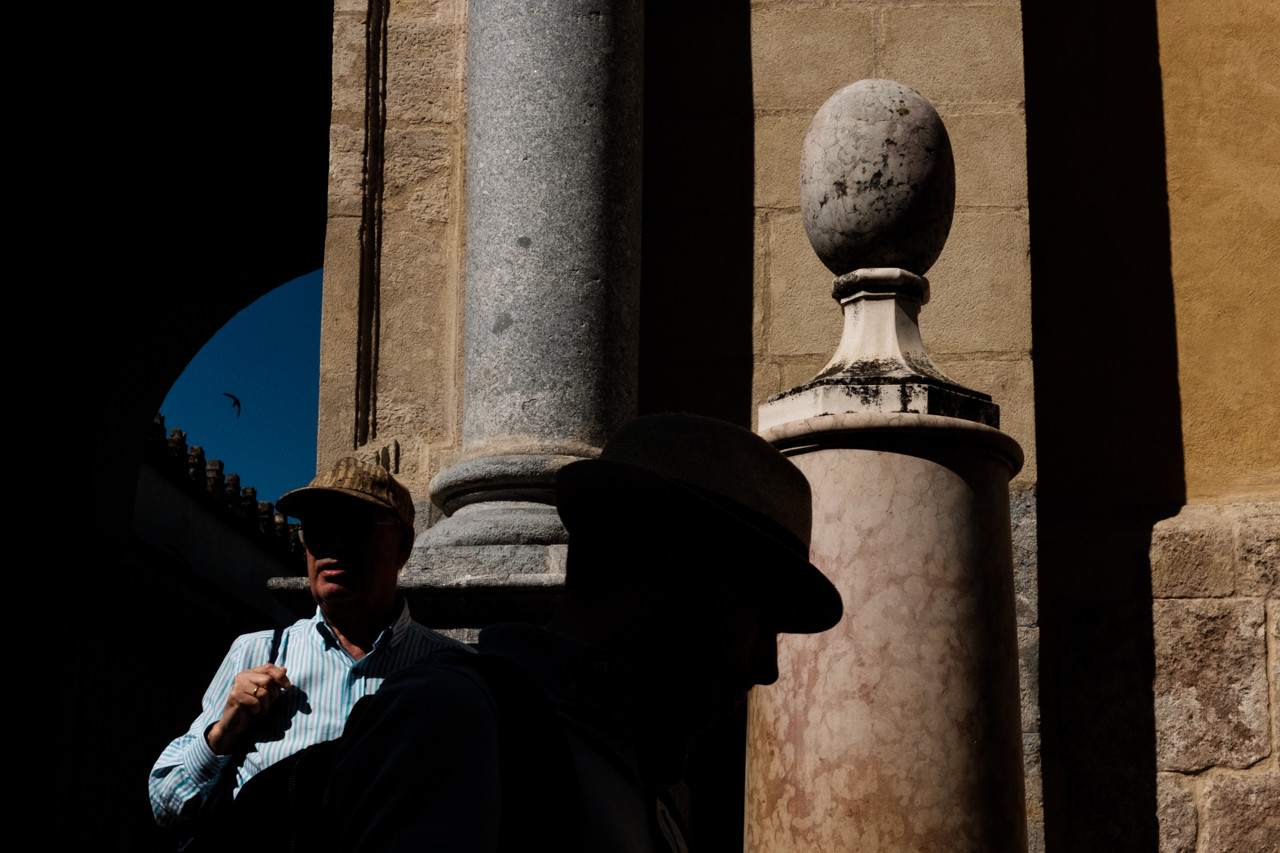Street photography: the very term sparks debate. What exactly is it? Is it about streets? Are there rigid rules? As a street photographer, I’m diving into these questions to offer clarity, explore definitions, and yes, even discuss those contentious rules. Consider this your trigger warning if you’re a stickler for tradition.
Let’s tackle the core questions:
1. Why Do We Need a Definition of Street Photography?
2. Is “Street” Photography Always About the Street?
3. Are Rules Essential in Street Photography?
Finally, I’ll share my perspective on what street photography truly means.
“The marvels of daily life are exciting; no movie director can arrange the unexpected that you find in the street.” — Robert Doisneau
1. WHY DO WE NEED A DEFINITION OF STREET PHOTOGRAPHY?
The need for a definition might seem academic, but it’s actually quite practical. Think about it: a definition provides a shared understanding. As dictionary.com aptly puts it, defining is “the act of making something definite, distinct, or clear.” In photography, where genres abound, definitions help us categorize and communicate effectively. Landscape photography, portrait photography, even wildlife photography – these genres have generally accepted boundaries. Yet, street photography often becomes a battleground of opinions.
The Encyclopaedia Britannica offers a solid starting point, defining street photography as:
“A genre of photography that records everyday life in a public place. The very publicness of the setting enables the photographer to take candid pictures of strangers, often without their knowledge. Street photographers do not necessarily have a social purpose in mind, but they prefer to isolate and capture moments which might otherwise go unnoticed.”
Some argue that definitions are restrictive, stifling creativity. But consider this: understanding the core tenets of street photography doesn’t prevent you from exploring other photographic avenues. You can be a street photographer who dabbles in documentary projects or infuses fine art principles into your street work. Without some form of definition, are you just a “photographer” in a sea of photographic specializations? While there’s nothing wrong with being simply a “photographer,” genre distinctions help us discuss and appreciate the nuances within the vast world of photography. The very term “street photography” itself is part of the confusion, leading us to the next question.
 A candid street photograph taken indoors, showing a woman in a vibrant pink coat against a muted background, highlighting the unexpected moments in everyday environments beyond just streets.
A candid street photograph taken indoors, showing a woman in a vibrant pink coat against a muted background, highlighting the unexpected moments in everyday environments beyond just streets.
2. IS “STREET” PHOTOGRAPHY ALWAYS ABOUT THE STREET?
Absolutely not. The term “street” photography is, in many ways, a misnomer. It’s limiting and can be misleading, especially to newcomers. While the name suggests images of streets, experienced street photographers understand that the “street” is merely a starting point, not the defining element. A photograph of an empty street, or even a street bustling with uninteresting activity, is simply a snapshot, not compelling street photography. This inherent ambiguity is part of what makes street photography such a debated subject.
Perhaps renaming the genre could alleviate some of the confusion. Nick Turpin, a respected street photographer, advocates for “Candid Public Photography” as a more accurate descriptor. He argues:
“It seems to me that Street Photography as a phrase now lets us down to some extent, it fails to identify the key aspects of our practice, namely that the work is shot without intervention, it is made in a public place (not necessarily the street) and it is a Photo Graph, drawn with light and not with a computer after the fact.” — Nick Turpin
Turpin’s point is valid. “Candid Public Photography” better encapsulates the essence of the genre. However, despite its accuracy, it’s unlikely to replace “street photography.” The term “street photography” is deeply entrenched in photographic history, associated with iconic figures and movements. It has become a brand in itself, like “Hoover” for vacuum cleaners – the literal meaning has become secondary to the established usage. Ultimately, street photography is less about photographing streets and more about a particular approach to photography.
“Street photography is an attitude, a state of mind, a way of being, rather than something that has to be done exclusively on the streets of cities.” — Matt Stuart
This “attitude” transcends physical streets. Street photography can thrive anywhere – indoors or outdoors. Inside a cafe, at a bustling market, in a quiet park, within a museum, or even a subway station – all become viable locations. You don’t even always need people; the evidence of human life can suffice. Street photography can be documentary, artistic, abstract, humorous, or narrative. It’s about capturing fleeting moments, interpreting reality, and observing the serendipitous unfolding of everyday life.
So, if street photography is so diverse in location and subject matter, what is it? It boils down to an approach, a set of guiding principles. And that leads us to the inevitable discussion of rules.
 A dynamic street photograph in color capturing a moment in a crosswalk, emphasizing composition and the decisive moment in urban life.
A dynamic street photograph in color capturing a moment in a crosswalk, emphasizing composition and the decisive moment in urban life.
3. ARE RULES ESSENTIAL IN STREET PHOTOGRAPHY?
Rules: the very word can be polarizing. Yet, in the context of defining street photography, some guiding principles are necessary. Without any rules, a definition becomes amorphous, the genre loses its distinctiveness, and we risk dissolving into a sea of undefined “photography.” A minimal set of rules helps establish boundaries and fosters meaningful discussion.
Now, I understand the aversion to rules. Creativity thrives on freedom. That’s why I advocate for minimalist rules in street photography – just enough to provide a framework for understanding and discussion.
Here are my proposed minimal rules of engagement for street photography:
- Candid and Unstaged: Street photography captures authentic moments. Posed or staged shots fall into the realm of portraiture or other genres. Candid photography is key.
- Presence of Life (or Evidence Thereof): Street photography engages with the human experience. While not every shot needs a person, there should be a connection to human life or its impact.
- Intrigue and Interest: Street photography should be more than a mundane snapshot. It should capture something compelling, whether it’s emotion, humor, beauty, or a unique perspective.
- Camera-Created: Street photography is rooted in the photographic process. While post-processing is part of photography, heavily manipulated digital art or composites move beyond the boundaries of street photography.
Within these broad guidelines, I believe there’s immense room for creative exploration and experimentation. However, the debate intensifies when we delve into the technology and techniques “allowed” within street photography. This is where things get truly contentious.
Suddenly, technology becomes a battleground of “acceptable” and “taboo.” Depending on who you ask, certain techniques are frowned upon, while others are embraced. The following is a general categorization based on common discussions within the street photography community (and I must emphasize, these are not necessarily my personal judgments):
Questionable Techniques:
- Double Exposure: Some purists view in-camera double exposures as straying too far from capturing a single, decisive moment.
Highly Questionable Techniques:
- Panoramic Algorithms (in Mobile Phones): Computational photography, like panoramic stitching, is sometimes seen as overly manipulative, moving away from the “straight” photographic approach.
Generally Accepted Techniques:
- Flash (Day or Night): Using flash, whether fill-flash in daylight or for dramatic effect at night, is widely accepted as a tool in street photography.
- Blur (Motion or Focus): Intentional blur, whether motion blur or shallow depth of field, is often used creatively in street photography.
- Noise (Grain): Embracing grain, whether from high ISO or film, is generally accepted and often adds to the aesthetic.
- Dark Shadows: High contrast and deep shadows are common stylistic elements in street photography.
- Distorted Wide Angles: Using wide-angle lenses for dramatic perspectives and capturing more of the environment is a long-standing street photography technique.
The crucial point is that if technology enables these effects in-camera, shouldn’t they be considered valid tools? As long as we are creating photographs with a camera, rather than constructing digital art after the photographic process, shouldn’t we embrace the evolving capabilities of our equipment?
Street photography itself has evolved significantly since its inception. Technological advancements have been integral to this evolution, largely embraced by photographers. It seems inconsistent to arbitrarily deem some technologies “acceptable” and others “off-limits.” Photography, at its core, is created with a camera. Without technology, photography wouldn’t exist.
Shouldn’t the potential of our cameras guide the continued evolution of street photography? If we rigidly adhere to outdated notions of what’s “pure,” we risk stagnation. Imagine if street photography remained confined to black and white film simply because color technology wasn’t initially available. While some photographers choose film for its aesthetic and process, most utilize digital cameras, DSLRs, mirrorless systems, and even mobile phones – all tools with varying technological capabilities. Why limit our creative expression by rejecting certain technological tools when technology is fundamental to photography itself?
I’ll state it boldly: experiment with blur, flash, double exposures, algorithms, fisheye lenses, motion, and any other in-camera technique at your disposal! Be creative, utilize technology as a tool, because that’s precisely what it is. Purists might disagree, and that’s fine. I once leaned towards purism myself, but questioning the arbitrary lines drawn between “acceptable” and “unacceptable” technology led me to a more open perspective. For example, using a powerful flash to create a bleached silhouette is accepted by many, yet in-camera double exposure is sometimes frowned upon, despite both being technologically enabled camera features. Neither technique would have been possible with the earliest cameras.
 A black and white street photograph with strong contrast and dynamic composition, showcasing a decisive moment with a sense of mystery and urban intrigue.
A black and white street photograph with strong contrast and dynamic composition, showcasing a decisive moment with a sense of mystery and urban intrigue.
MY DEFINITION OF STREET PHOTOGRAPHY
For me, street photography is profoundly personal and observational. It’s about capturing what you notice, what sparks your curiosity, what you find beautiful, interesting, or humorous in the everyday world. Place a group of street photographers in the same location, and each will find something unique to photograph, or at least interpret the scene differently.
Street photography is a powerful medium for sharing your unique perspective. Through framing, composition, timing, and decisive moments, we reveal what we see in the world. It’s an exercise in creativity within the uncontrolled, ever-changing environment of public spaces.
FINAL THOUGHTS
Let’s maintain just enough rules to differentiate street photography from other genres, providing a framework for understanding and discussion. But let’s also embrace creative evolution within those guidelines. Photography is inherently technology-dependent, so restricting techniques based on a romanticized view of the genre is counterproductive. Ultimately, our vision identifies photographic possibilities, our imagination crafts narratives, and our creativity constructs the image.
“Street photography is the art of observation, anticipation and imagination, combined with the science of composition.” — Polly Rusyn
Words and pictures © Polly Rusyn | All Rights Reserved
